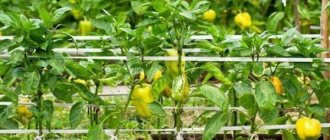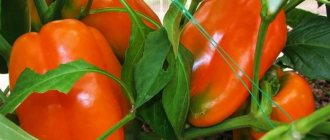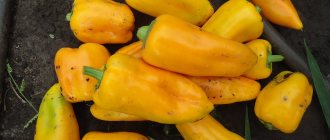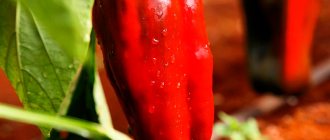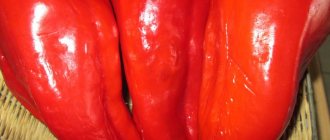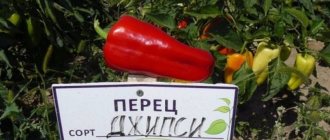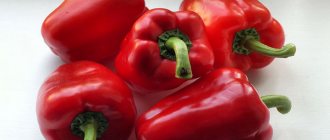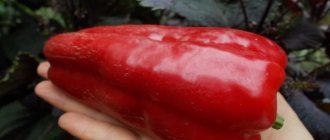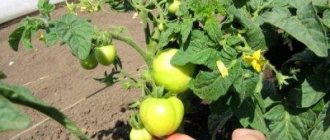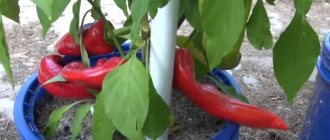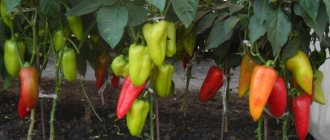Pepper is very popular among gardeners. The modern market offers a wide selection of different varieties of this healthy vegetable. All options differ in size, shape, taste, aroma, fruiting period, disease resistance and growth characteristics. Which variety should you prefer? Beginning vegetable growers are often lost in diversity. Therefore, the article will consider pepper varieties for the Moscow region and Siberia, which are worth paying attention to, as they have gained a good reputation and are in demand among amateur summer residents and professional farmers.
Description and characteristics of the variety
Red Riding Hood is a mid-early cultivar. The period from mass germination to the formation of fruits at technical ripeness is 110-120 days. Ripening times largely depend on growing conditions and weather conditions.
In the description of the variety, the originator indicates that Red Riding Hood is unpretentious to light and calmly tolerates night and day temperature changes after planting in a permanent place.
The plant forms a medium-sized bush, not exceeding a height of 0.7-0.8 m in a greenhouse. In open ground, the central stem may finish growing a little earlier, without reaching these marks.
The variety is classified as semi-standard. This means that the plant has a fairly powerful main stem, good foliage and a compact crown. A large number of leaves darken the fruits, saving them from sunburn in hot weather.
Each plant produces 6 to 8 fruits at a time. During the season, an average of 12 peppers are harvested from one bush, which is a total weight of 2.5 kg of the crop.
The red cap forms fruits in the form of a cube up to 10 cm long. The flesh of the peppers is fleshy, the thickness of the pericarp walls is 8 mm (see photo).
The weight of one vegetable at technical ripeness is on average 200 grams. When they reach biological maturity, peppers can be poured up to 250 grams directly on the bush.
When set, the vegetables are a rich dark green color, which changes to bright red when fully ripe.
Juicy and tasty fruits with a pronounced peppery taste can be consumed at technical ripeness. But they reveal their full flavor potential only after they turn red.
It is recommended to remove peppers from the bushes at the stage of technical ripeness so that they do not draw nutrients onto themselves from the formed ovaries. The fruits ripen well at home.
Vegetables are good for fresh consumption and are also suitable for various types of culinary processing.
Variety or hybrid - what to choose?
Varietal crops are natural or artificially selected types of peppers. Their fruits can be adapted to certain conditions, for example, climatic, and seed material can be obtained from them. Thus, saving on the purchase of seeds for the new season and having the opportunity to grow your favorite type of pepper.
Scientists and breeders are involved in
creating
hybrids The F1 hybrid is always better than its predecessor, but it cannot produce seeds for further work and is not adaptable to certain conditions.
Important! Previously, it was believed that hybrid products had a less pronounced taste and aroma, but modern selection makes it possible to grow such a vegetable with excellent taste.
In fact, if you purchase seeds from trusted producers, it doesn’t really matter whether it is a hybrid or a variety. In both the first and second cases, you can get a good harvest of tasty peppers. Much more important are the conditions in which the vegetable will be grown and proper care for it.
Popular varieties
- Pepper "Black horse" — the black pigment of the skin has a beneficial effect on the human body. It contains substances that actively fight colds and improve vision. The early variety ripens in 95-100 days, which can be grown even in winter on a windowsill. Fruits weigh 150-250 g, wall thickness 9-10 mm. Not susceptible to late blight and blossom end rot, resistant to most pests.
- "Magnificent century" - a variety with a ripening period of 105 days with fairly large fruits weighing up to 180 g, purple in color on low bushes (45 cm). An unpretentious vegetable with a yield of up to 6 kg/sq. m. One of the best varieties for stuffing.
- "Egyptian force" - bred in Siberia, and received its name for the shape of the fruit, reminiscent of pyramids and orange color - the color of the sun and sand in Egypt. An early ripe variety (95-100 days) of sweet pepper with good yield up to 6 kg/sq. m, perfect for a greenhouse or open ground. Resistant to sudden changes in temperature and humidity, as well as most pests. Fruit weight 130-150 g, thick wall up to 1 cm.
- "Chernobrovka" - high-yielding mid-season (135-145 days) chocolate-colored variety. The fruits are cube-shaped, fleshy, smooth, weighing 150-220 g, wall thickness 8-10 mm. Fragrant, sugary, loses color during heat treatment. Used mainly for consumption in salads. Grown in open and closed ground, bushes 80-120 cm high.
- "Eroshka" - loved by many gardeners because it can be grown in a thickened way, leaving up to 15 cm between plants. The cube-shaped fruits are colored red and weigh up to 160 g. From one bush 50 cm high you can collect 16 pieces, technical ripeness occurs 95 days after germination. Thanks to its thin walls, this pepper can be stored at the right temperature for up to 3 months.
The best hybrids
The best hybrid varieties of sweet peppers include the following:
- "Morozko" – cold-resistant, mid-ripening (110-115 days) hybrid variety with scarlet small cone-shaped fruits. Not tall bushes 50-70 cm, not afraid of May and June frosts. Contains a large amount of vitamin C, carotene, glucose, protein, mineral salts and vitamins E, C, B1, P1, B3.
- "Gemini F1" - Dutch, with ripening 80-90 days, a completely unpretentious hybrid with bright yellow fruits and a good yield of up to 9 kg per square meter.
- "Atlantic F1" - another Dutchman with very large (up to 470 g) fruits and a yield of 12 kg/sq. m, designed for open ground. The taste has a piquant bitterness, but this only adds to the popularity of the Dutch giant.
- "Bear in the North F1" - domestic varietal hybrid. The name speaks for itself. Resistant to cold, can live even in the north, albeit under cover, low bushes with bright scarlet large-sized vegetables. Productivity is up to 7 kg/sq.m. m.
- "Belladonna F1" — we cannot fail to mention the earliest ripening and highest-yielding hybrid for indoor soil. With a ripening period of 80-90 days, you will collect up to 15 kg/sq. m pale yellow fleshy and aromatic fruits.
Features of cultivation and care
The timing of planting seeds for seedlings of the Red Riding Hood variety is the last week of February - the first ten days of March. In the southern regions and when cultivated in greenhouses, sowing is carried out earlier.
The gardener should be guided by the fact that seedlings appear on average after 7-10 days (sometimes later), and seedlings are transplanted to a permanent place at the age of 60-70 days. By this time, the risk of return frosts should have passed, and the first buds should appear on the plants. Those. sowing is carried out approximately 80 days before transplanting into the ground.
The originator recommends placing it on sq. m. 3-4 plants. However, many gardeners practice the thickened planting method, planting up to 10 bushes in such an area.
In a greenhouse, to increase productivity, the cultivar is formed into two stems, and a trellis is used as a support.
Some vegetable growers grow Little Red Riding Hood without staking and shaping. However, without support, the stems can lie on the ground, and the formed fruits can rot.
To improve air circulation between the bushes and simplify watering, remove shoots and yellowed leaves before the first fork.
Pepper grows well and forms a rich harvest on loamy soils. In addition to high-quality soil, the crop needs watering every 3-4 days. For humidification, use only settled, non-cold water. It is recommended to carry out the procedure in the evening. Water the plants strictly at the roots, without getting on the foliage. Caring for the crop also includes loosening the soil and weeding.
Landing
The sowing period lasts from mid-February to the end of March. Before planting, it is advisable to treat the seeds:
- Soak in heated water.
- Disinfect (Fitosporin, manganese solution).
- Stimulate (folk remedies - aloe, honey, as well as humate or Immunocytophyte).
To grow strong seedlings, you need nutritious soil with compost and phosphorus-potassium supplements. A special microclimate is created for the bushes with a temperature of 20-26 degrees, humidity at 60-70%.
Diseases and pests
According to reviews from vegetable growers, the Red Cap sweet pepper is resistant to the main nightshade diseases. Despite this, you should still follow agrotechnical rules that will help avoid problems with plant health. Disease prevention comes down to the following measures:
- compliance with crop rotation;
- removal of yellowed foliage;
- treatment with biofungicides;
- regular inspection of bushes.
To prevent peppers from being favored by harmful insects, repellent plants (tansy, calendula, etc.) are planted nearby.
The best types of hot peppers
Hot pepper is used in many preserves; it is also indispensable when preparing meat dishes. Representatives of the Caucasus consume it in its pure form during meals. It can be grown in open ground, greenhouses or on windowsills. Let's look at the best varieties of this fiery seasoning:
- Jalapeño is a type of chili pepper, quite hot, but inferior in bitterness to some of its fellows. It is baked on the grill, added to first courses, stewed, and used in seasonings.
- Red hot - a hot type of pepper, the fruits are spherical or in the form of pods.
- “Indian Summer” is a variety of domestic pepper, it is a low bush strewn with small spherical fruits.
- “Queen of Spades” is a variety for open ground with small spherical bushes with many fruits of varying degrees of ripening and different colors. Looks very nice.
- "Dragon's tongue" is a hot, aromatic capsicum used in the production of paprika.
- “Vizir” - used for preservation, a late-ripening variety with a very interesting and unusual shape in the form of an oriental headdress. This is where it got its name.
- “Tabasco” is a hot pepper from which the famous sauce of the same name is produced.
Advantages and disadvantages
Based on the reviews of summer residents and the characteristics of the originator, the following advantages of the Red Riding Hood sweet pepper should be highlighted:
- tasty, large and beautiful fruits of universal use;
- high yields in any growing conditions;
- resistance to short-term cold snaps;
- good tolerance to lighting deficiency;
- universal use in cooking.
Among the disadvantages is the need to fix the central stems to supports, which can fall to the ground due to the heaviness of their fruits.
By growing method
Among the pepper varieties you can find universal ones, those that are equally suitable for open and closed ground. But there are also varieties that are intended for sowing only in a certain place.
Pepper varieties for open ground
For open beds, the following bell pepper seeds have proven themselves to be:
- "Asti" — stands out for its smooth early ripening red peppers (90-100 days) with a slight gloss on the surface. A super-yielding variety of Italian selection, perfectly adapted to the harsh conditions of Siberia.
- "Indalo F1" - a hybrid with cube-shaped fruits 12x12 cm, beautiful bright yellow color, weighing up to 300 g, wall thickness up to 10 mm. From germination to technical ripeness 105–110 days, to biological ripeness 125–130 days. The plant is indeterminate, up to 1.5–2 m high.
- "Cardinal" - an early-ripening eggplant-colored vegetable (exotic dark purple hue), resistant to pests and excellent yield reaching up to 14 kg/sq. m. Ripens 90-100 days after germination.
- "King Kong" - a giant pepper, the weight of the fruits of which reaches a maximum of 500 g (the average weight of the fruit is 200-300 g). The fruits are cuboidal, smooth, pericarp 5-7 mm. In technical ripeness it is green, in biological ripeness it is dark red. Harvest 120-125 days after germination.
Pepper varieties for the greenhouse
The best sweet pepper seeds for greenhouses, greenhouses and greenhouses for the 2021 season, without a doubt, include:
- "Sonata F1" - an early-ripening red vegetable with fleshy fruits weighing 200 g. Strong bushes reach 2 m and they definitely need support.
- "Triton" - low bushes and medium-sized peppers up to 150 g. From bright yellow to, after reaching maturity, red color.
- "Mammoth Tusks F1" — red and yellow peppers, shaped like mammoth tusks, look great on branches and preserved. The pulp is tender, without any bitterness.
- "Miracle Tree F1" - tall, up to 2 m, the bush is generously strewn with red triangles only 8-10 cm long and weighing 35 g.
- "Martin" - red peppers, weighing about 100 g, medium ripening.
Similar varieties
According to the characteristics and description of the variety, Red Riding Hood is similar to the following varieties of pepper:
- Big Boy;
- Red side;
- Quadro ed;
- California miracle;
- Fatty.
The Big Boy variety belongs to the Aelita agricultural company. The crop yields milky ripeness after 110 days. It can form fairly tall bushes in a greenhouse (up to 1 m), in open ground it rarely exceeds 0.5 m. The shape of the fruit is cubic, weight is up to 200 g.
The red side begins to bear fruit on average after 105 days. Red cube-shaped fruits are poured up to 250 g. subject to complete ripening in the vegetative system of the plant. The cultivar is not afraid of the main nightshade diseases.
Quadro red belongs to the mid-early varieties of Siberian selection. This means that pepper is resistant to unfavorable climatic conditions. The cube-shaped fruits are in many ways similar to Little Red Riding Hood: they are large (up to 300 grams), thick-walled (7-8 mm), and bright red when fully ripe. One plant brings up to 2.5 kg of harvest.
On average, the California miracle pepper begins to bear fruit 130 days after sowing the seeds for seedlings. The variety is adapted to any weather conditions. The powerful central stem, 80 cm high, has good foliage. Cube peppers weighing up to 160 g. form a pericarp wall up to 9 mm. The cultivar is resistant to verticellosis. Productivity per sq. m. under film covers is 8-10 kg.
The mid-early cultivar Tolstyachok forms a harvest after the beginning of the growing season after 120-130 days. The semi-spreading plant, no more than 55 cm high, bears up to 12 fruits. Cuboidal red peppers are distinguished by their large fruit (up to 250 grams) and thickness (up to 1 cm). Unlike Little Red Riding Hood, the bush does not need shaping or staking.
Rating of pepper seeds with description and photo
If you have not yet decided on the choice of seeds for planting pepper seedlings, then hurry up! Among the varieties of bell pepper, the following varieties have gained unshakable fame:
"California Miracle"
This mid-early variety, the ripening period is about 120 days after planting the seedlings, was developed almost a hundred years ago and has not yet lost its relevance.
The bushes are distinguished by their power and strong trunks, and the fruits reach a length of more than 6 cm. They have juicy pulp and thick walls. The vegetable is sweet due to its high sugar content.
At the beginning of ripeness, the fruits are green in color, and then turn red and become crispy. The yield reaches 10 kg per square meter.
"Bogatyr"
The ideally even and smooth fruits of the Bogatyr varietal pepper have an elongated shape of a dark red color with a thick but soft skin.
This is a mid-season domestic species, obtained in the 90s of the last century by Moldovan breeders. With an average ripening period of 150 days , the yield per square is 7 kg.
Excellent for raw consumption, stewing, grilling.
"Martin"
One of the varieties optimally suited for growing in greenhouses . Its fruits are shaped like a cone with thick skin.
The weight ranges from 100 grams and from one square meter you can get up to 6 kg of vegetables.
The fruits come in different colors - green, yellow and red, depending on the period of ripening.
"Ramiro"
One of the sweetest varieties of Italian origin. Mid-season, the harvest is harvested 130 days after germination.
The height of the bush is 60-80 cm. The fruits reach a size of 10 cm and a weight of 150 grams, and are red in color.
Excellent for stuffing with meat, rice and vegetables due to its delicate, but not very thin skin. Due to its oblong shape, it is more reminiscent of hot pepper.
"White gold"
Early ripening pepper, created for the harsh northern territories by Russian scientists. Now it has become widespread in central and central Russia.
It is characterized by ripening 110 days after planting, large cube-shaped yellow fruits, weighing up to 250 grams and a pronounced sweet taste.
The bush is compact and strong. The fruits are used for making lecho, salads and stuffing.
"Gift of Moldova"
Known since the 1970s, Moldovan pepper is well grown throughout the Russian Federation and adapts well to any climate, except subarctic. It is preferable to grow in sunny areas of open ground.
Small bushes allow you to get fruits by growing peppers even in pots on balconies. The fruit at ripeness acquires a light red hue.
A mid-early variety, it produces a harvest in 120-125 days. The fruits are suitable for canning due to their small size, 8-10 cm and weighing 90-120 grams.

